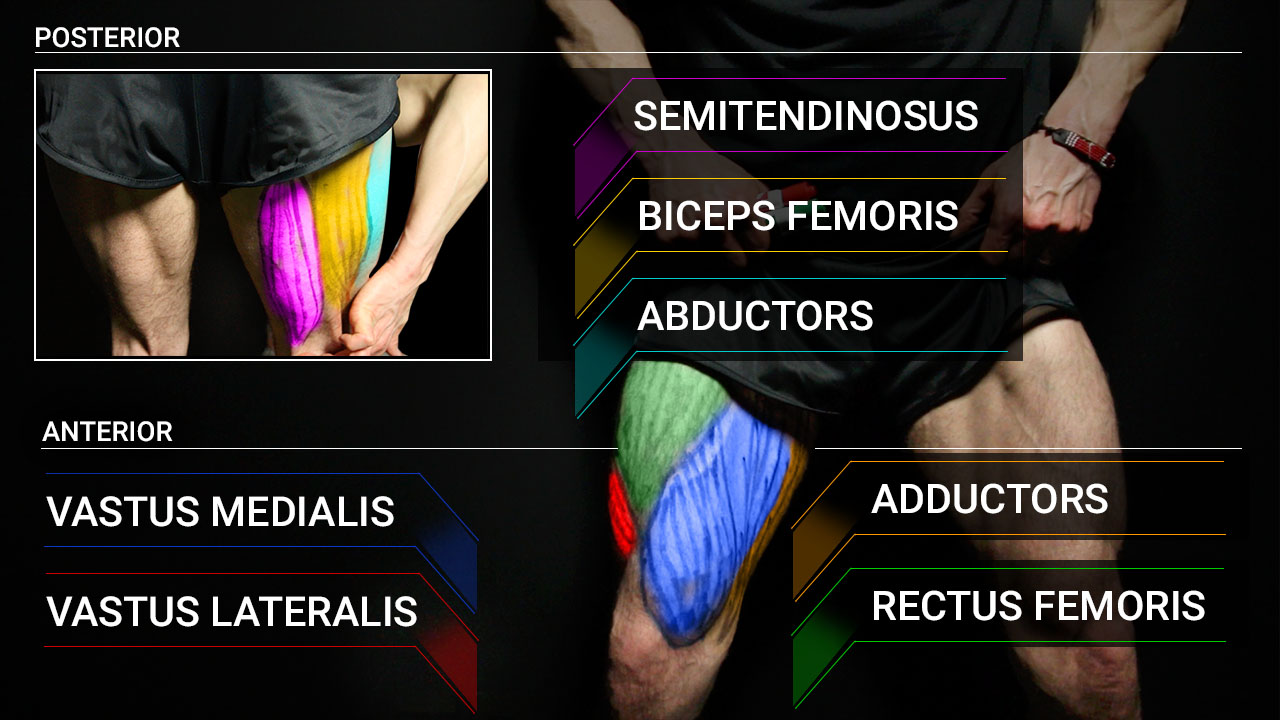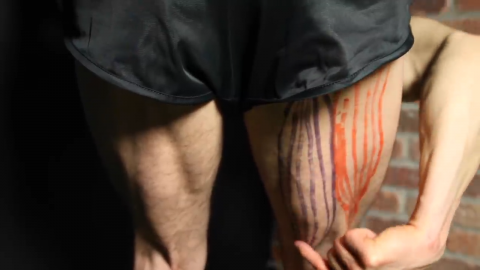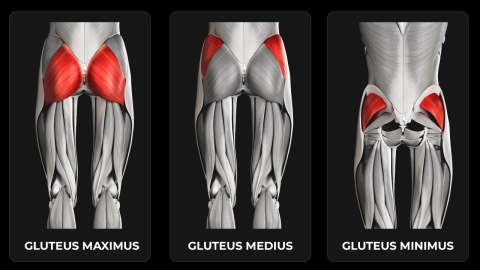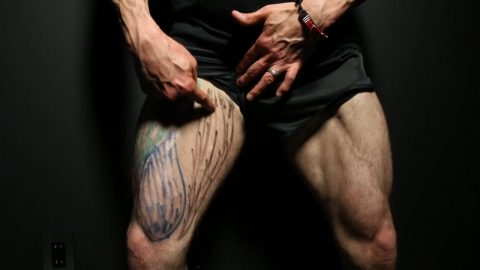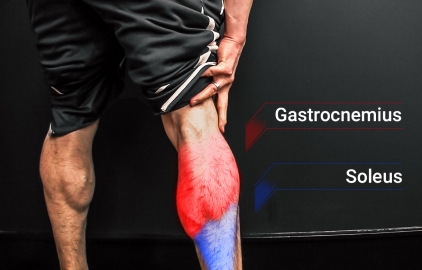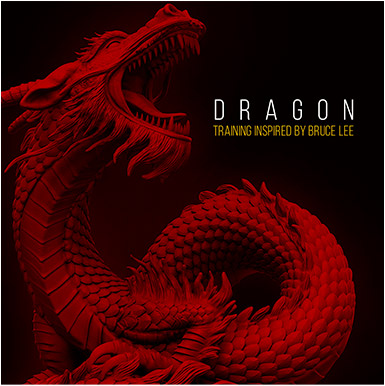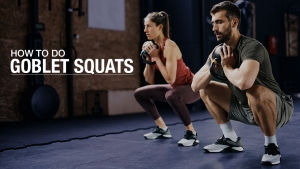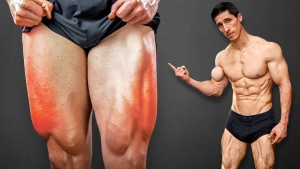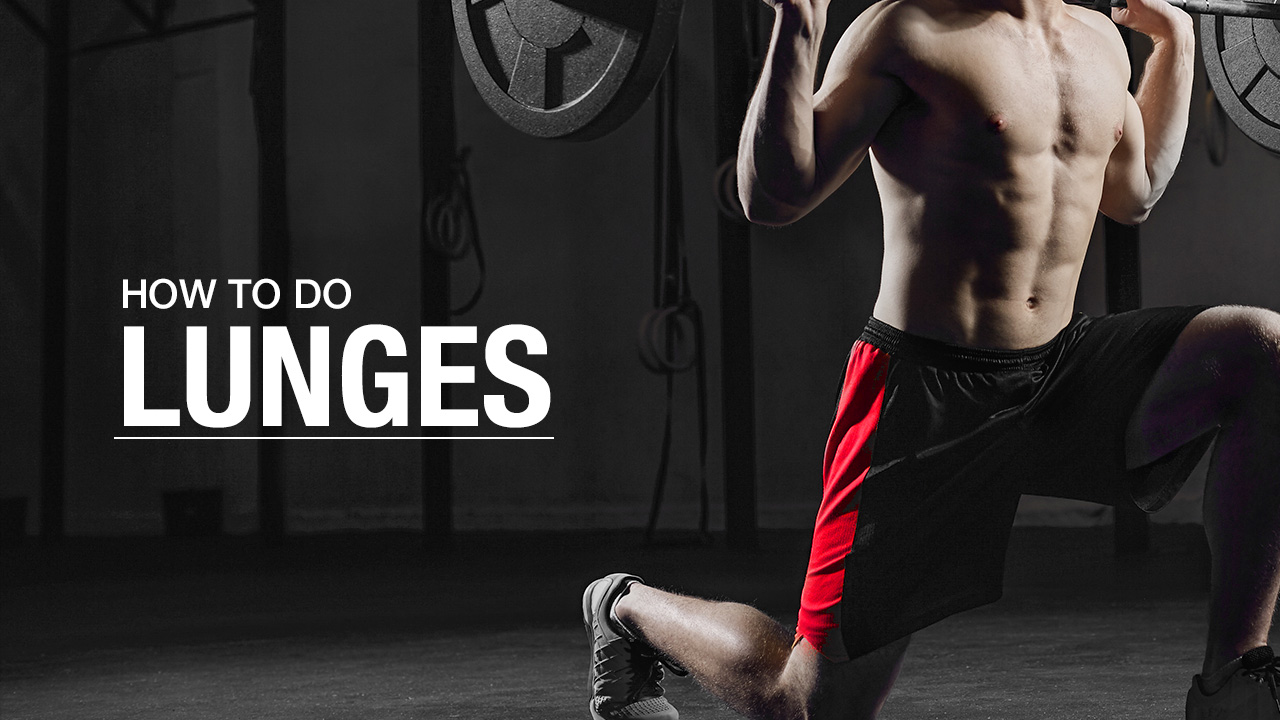
ARE YOU DOING LUNGES CORRECTLY?
Stop! If you’re still doing Forward Lunges, you might be setting yourself up for injury and frustration.
Yes, you heard that right.
Forward Lunges, one of the most common strength training exercises in fitness routines, could be more harmful than helpful if not done correctly.
Don’t get me wrong:
Lunges are a powerhouse move, targeting multiple muscle groups and improving your balance, coordination, and strength.
However, not all lunges are created equal.
Choosing the right type of lunge and executing it with perfect form is crucial to reaping the maximum benefits and avoiding common pitfalls.
In this article, I’m diving deep into the world of Lunges, uncovering the best techniques, the anatomy of the muscles involved, and variations that can take your leg workouts to the next level.
Ready to learn the secrets behind the perfect lunge? Let’s get started!
LUNGES: MUSCLES WORKED
To get the most out of your Lunges, you need more than just good form—you need a rock-solid mind-to-muscle connection.
It’s not just about moving your legs up and down; it’s about engaging the right muscles, feeling each contraction, and making every rep count.
This is where true muscle growth and strength gains happen.
Understanding the specific muscles targeted by Lunges allows you to focus your efforts, ensuring that each Lunge is an effective exercise that builds strength and stability.
In this section, I’m going to break down the key muscles worked during Lunges and show you how to harness the power of your mind to optimize every rep.
Get ready to feel the burn and see the results!
QUADRICEPS
True to its name, the quadriceps are actually a group of four distinct muscles:
VASTUS MEDIALIS


The vastus medialis, a key muscle in your quadriceps, is located on the inner thigh and stabilizes the knee during various lunge exercises.
Essential for knee extension, this muscle is activated in movements like Basic Lunges, Walking Lunges, and advanced variations such as Jumping Lunges and Curtsy Lunges.
When stepping into a lunge position, whether using body weight or additional light weights like dumbbells or a medicine ball, the vastus medialis engages to extend the knee and maintain stability.
This is crucial for preventing knee pain and injury, ensuring smooth knee joint motions.
VASTUS INTERMEDIUS

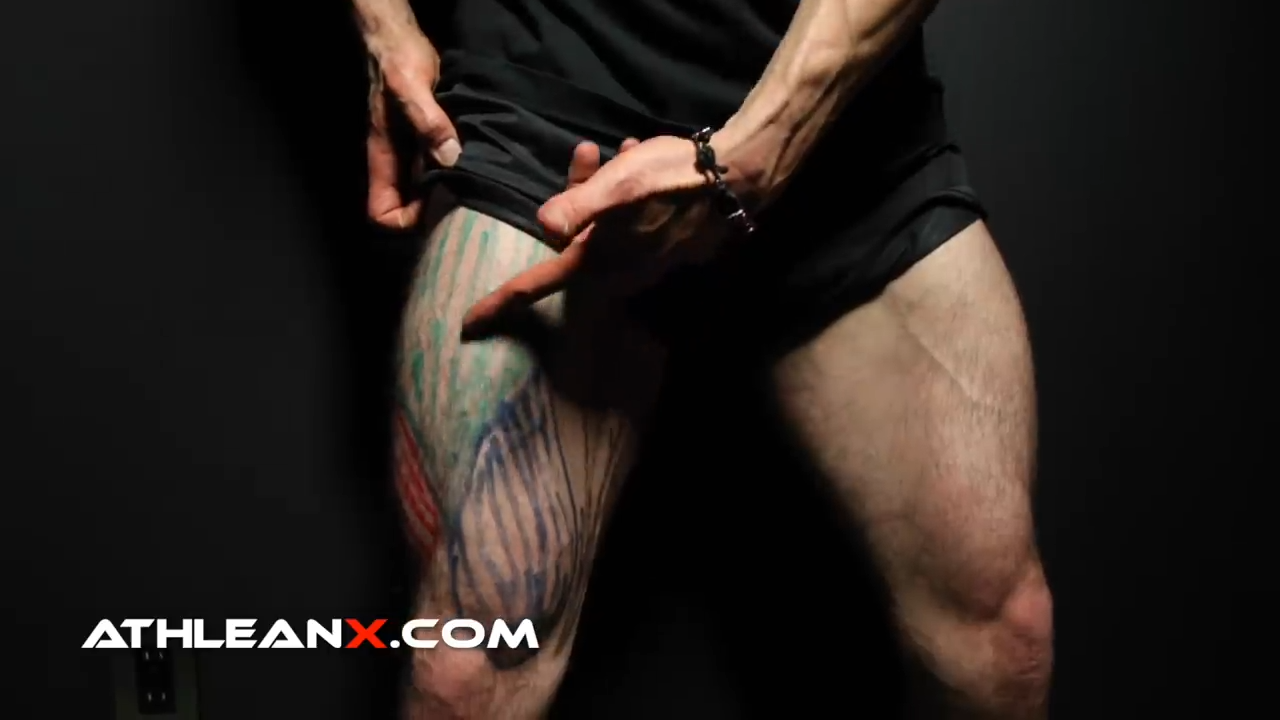
The vastus intermedius, located deep within the thigh, is essential for knee extension and stability during Lunge exercises.
Though not visible, it’s crucial for functional movements like Reverse Lunges, Twist Lunges, and Lateral Lunges.
As you step into a lunge position, the vastus intermedius activates to support knee extension and prevent knee pain.
VASTUS LATERALIS

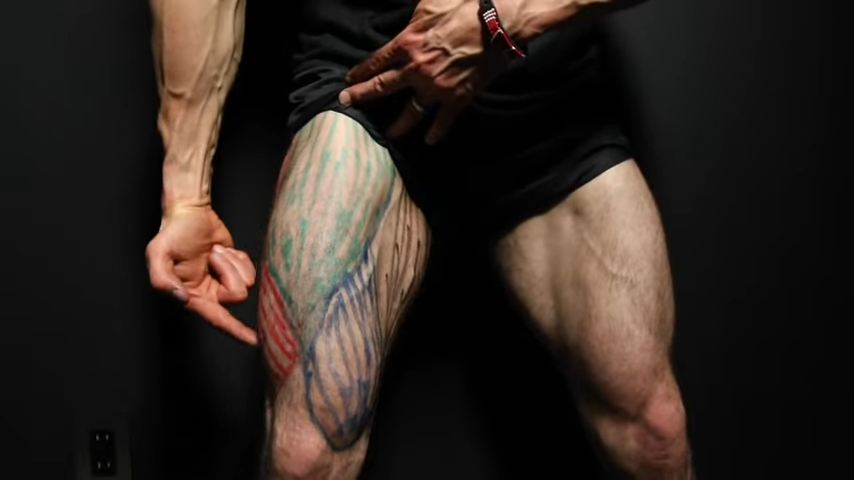
The vastus lateralis, located on the outside of the knee, is the largest muscle in the quadriceps group.
It originates from the femur and extends down to the patella, playing a crucial role in knee extension and stability.
Deep Lunges are a great way to activate this muscle group.
RECTUS FEMORIS

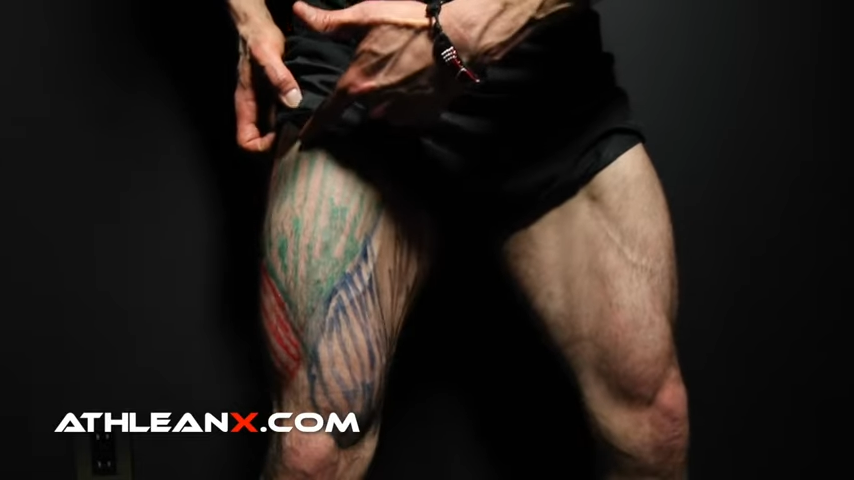
The rectus femoris originates from the ilium (pelvis) and runs down the front of the thigh to attach to the patella.
This muscle is unique because it crosses both the hip flexors and knee joints, playing a crucial role in knee extension and hip flexion.
It is heavily engaged during activities like running, jumping, and Lunges, contributing to overall leg strength and stability.
HAMSTRINGS
Let’s change to the posterior muscles on the back of your legs, and you’ll find the powerful hamstring muscles.
These muscles help with hip extension, knee flexion, and overall leg stability.
The hamstrings consist of the biceps femoris and semitendinosus.
BICEPS FEMORIS

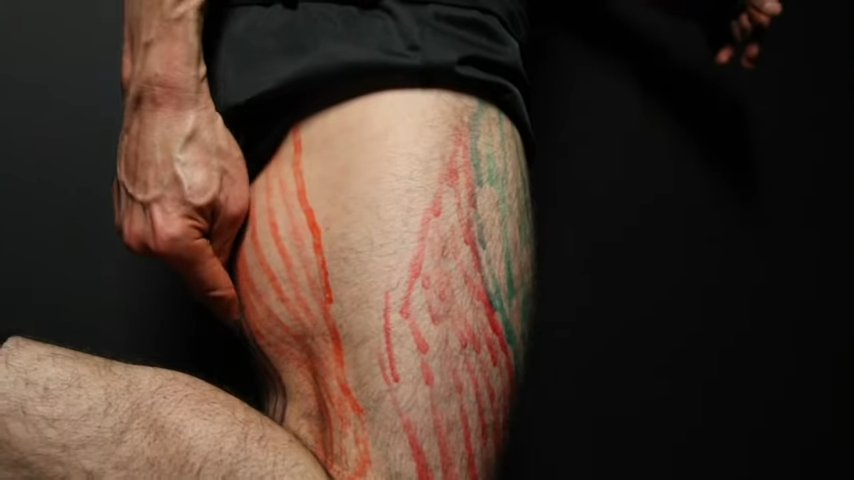
The biceps femoris is the lateral component of the hamstrings, located on the outside of the thigh.
This muscle has two parts: the long head, originating from the ischial tuberosity of the pelvis, and the short head, originating from the linea aspera of the femur.
Both heads insert at the head of the fibula.
The biceps femoris is responsible for knee flexion and hip extension, playing a role in movements such as running, jumping, and Lunges.
SEMITENDINOSUS
The semitendinosus is located on the inner side of the hamstrings, originating from the ischial tuberosity of the pelvis, and inserting at the medial surface of the tibia.
This muscle works alongside the other hamstrings muscles to facilitate knee flexion and hip extension.
It is essential for stabilizing the knee joint and supporting powerful leg movements.
GLUTES
When people think of glute muscles or butt muscles, they often imagine a single muscle, but it’s actually a group of three: the gluteus maximus, gluteus medius, and gluteus minimus.
GLUTEUS MAXIMUS
The gluteus maximus is the largest and most recognizable of the gluteal muscles (buttock muscles).
Originating from the upper part of the hip bone and the lower end of the spine, it extends down to attach to the iliotibial tract and the back of the thigh bone.
Its functions include hip extension, which is essential for movements like standing up, climbing stairs, and running.
It also contributes to outward rotation of the thigh, helping to stabilize the hip joint.
Additionally, the gluteus maximus is involved in thigh abduction, moving the thigh away from the body when the hip is flexed, and provides postural support, helping maintain an upright posture and lower back health.
It also stabilizes the sacroiliac joint, supporting the area where the spine meets the pelvis.
GLUTEUS MEDIUS
The gluteus medius, less known but equally important, originates from the outer surface of the ilium and inserts on the greater trochanter of the femur.
Its primary function is hip abduction, moving the thigh away from the body’s midline, which is important for walking and running.
The gluteus medius also assists in both medial and lateral rotation of the thigh, depending on the position.
It plays a vital role in pelvic stability, especially when standing on one leg, and contributes to overall posture by stabilizing the pelvis.
GLUTEUS MINIMUS
The gluteus minimus, the smallest gluteal muscle, originates from the lower portion of the hip bone and attaches to the front part of the greater trochanter.
Despite its size, it plays vital roles in hip abduction, supporting side-to-side movements and balance during walking and running.
The gluteus minimus also helps rotate the thigh inward when the hip is flexed, aiding in medial rotation.
Additionally, it is needed for stabilizing the pelvis, especially on one leg, and helps maintain overall body posture during movement.
The Semitendinosus, positioned on the inner side of your hamstrings, works in conjunction with the Biceps Femoris to facilitate knee flexion and hip extension, ensuring balanced and effective leg movements.
ADDUCTORS / ABDUCTORS
Often overlooked, the adductors and abductors are crucial for maintaining proper leg function and stability.
ADDUCTORS
The abductors, found on the outer thigh, are responsible for moving your legs outward.
These muscles are essential for maintaining stability during single-leg exercises and activities.
Strengthening the abductors helps prevent muscle imbalances and enhances overall leg stability and function.
THE CALVES
The calves, located at the bottom of the leg, consist of two main muscles: the gastrocnemius and the soleus.
GASTROCNEMIUS
The gastrocnemius is the larger, more visible part of the calf muscle.
Originating from the femur, it inserts into the heel via the Achilles tendon.
Its primary functions are leg flexion at the knee and plantar flexion at the foot, essential for movements like jumping and running.
SOLEUS
The soleus lies beneath the gastrocnemius, originating from the tibia and fibula and also attaching to the heel via the Achilles tendon.
Although less prominent, the soleus plays a crucial role in building well-rounded calves.
It aids in plantar flexion, particularly during activities that involve standing and walking.
By increasing the size of the soleus, you can push the gastrocnemius outward, giving your entire calf a larger and more developed appearance.
WHAT IS THE BEST TYPE OF LUNGE?
A lot of you may be here to learn how to perform the Forward Lunge correctly, but is that really the best type of lunge you should be doing?
I’d argue that most of you should be looking elsewhere.
Why?
The Forward Lunge can be particularly hard on the knee for several reasons.
Firstly, the front leg is in an open chain position and absorbs a lot of force the moment your foot hits the ground.
In an open chain exercise, the working limb is not in contact with the ground or a stable surface, unlike closed chain exercises where the limb is anchored.
Secondly, the quadriceps muscles are stretched when the knee is already partially flexed.
In this eccentrically loaded position, the landing force goes directly into the patella tendon, creating significant knee pain with every rep.
This setup feels like a knife digging into your knee, making Forward Lunges a risky move for those with knee issues.
For a safer and more effective alternative, consider the Reverse Lunge.
In this lunge variation, the back leg stays in contact with the ground, making it a closed chain exercise that provides better stability and reduces stress on the knee joint.
This position allows for proper form and balance, engaging the core muscles and leg muscles more effectively.
Reverse Lunges can help address muscle imbalances and build functional strength without the high risk for injury associated with forward lunges.
Incorporating Reverse Lunges into your workout routine can enhance flexibility, muscle mass, and overall body strength.
These lunges engage major muscles such as the glutes, hamstrings, and quadriceps, while also improving core stability and upper body posture.
For added resistance and intensity, try using dumbbells or a medicine ball.
Ultimately, Reverse Lunges and other lunge variations provide a safer, more effective way to strengthen your legs and improve your fitness without the knee pain associated with forward lunges.
Whether you are using body weight, lighter weights, or heavier weights, focusing on proper form, and incorporating a variety of lunge exercises can significantly benefit your health and fitness routine.
BENEFITS OF REVERSE LUNGES
Reverse Lunges are not just an alternative to Forward Lunges; they offer a host of advantages that make them a superior choice for many of you.
Whether you’re looking to protect your knees, engage key muscles more effectively, or improve overall stability, Reverse Lunges can elevate your workout routine.
Here’s why Reverse Lunges should be your go-to lunge variation.
KNEE-FRIENDLY MOVEMENTS
One of the biggest benefits of Reverse Lunges is their knee-friendly nature.
When you step back into a lunge position, your rear knee absorbs the impact gradually, reducing the risk of knee injury.
This is a major advantage over Forward Lunges, where the front knee takes a direct hit.
Reverse Lunges allow your knee joint to move through a safer range of motion, protecting your knees while still engaging key muscles.
ENGAGING THE RIGHT MUSCLES
Reverse Lunges effectively target the gluteal muscles, hamstring muscles, and quadriceps muscles, ensuring balanced leg development.
By stepping back, you activate the glutes and hamstrings more intensely, which helps in building the largest butt muscle and stabilizing muscles around the knee.
This makes reverse lunges an essential movement in your lower body exercise routine.
IMPROVING BALANCE AND STABILITY
Reverse Lunges enhance your balance and stability.
They require core strength to maintain an upright position, engaging your abdominal muscles and stabilizer muscles throughout the movement.
This not only improves your balance but also strengthens your core, making everyday movements easier and more controlled.
VERSATILITY AND ADAPTABILITY
Reverse Lunges can be incorporated into various workout routines and circuit training workouts.
Whether you’re using the exercise without weights, dumbbells, or additional weight like a medicine ball, reverse lunges offer versatility.
You can include them in Static Lunges, Stationary Lunges, Stepping Lunges, and even advanced lunge variations like Jumping Lunges or Combo Lunges.
This adaptability makes them popular workouts among fitness trainers and enthusiasts alike.
CORRECT FORM AND FUNCTION
Maintaining the correct lunge form during Reverse Lunges is crucial.
Start with your feet shoulder-width apart, step back with your left foot, and lower your body until your thigh is parallel to the ground.
Keep your upper body upright and engage your core muscles for stability.
This proper form helps in preventing common mistakes and maximizing the benefits of the lunge exercise.
INCORPORATING REVERSE LUNGES INTO YOUR ROUTINE
For optimal results, include Reverse Lunges in your daily lives and fitness routine.
They can be part of your total body strength routine, added to circuit training workouts, or used in a 30-day Lunge challenge.
By varying the intensity with challenging weights or extra weight, you can continuously push your limits and achieve better health and fitness.
Reverse Lunges are a powerful tool for building functional strength, enhancing flexibility, and improving overall leg health.
Make them a regular part of your workout to enjoy these benefits.
HOW TO DO REVERSE LUNGES
Dumbbell Reverse Lunges are a fantastic way to build leg strength and improve overall stability.
Here’s how to execute them with correct form, incorporating several fitness tips to maximize benefits and avoid common mistakes.
DUMBBELL REVERSE LUNGE

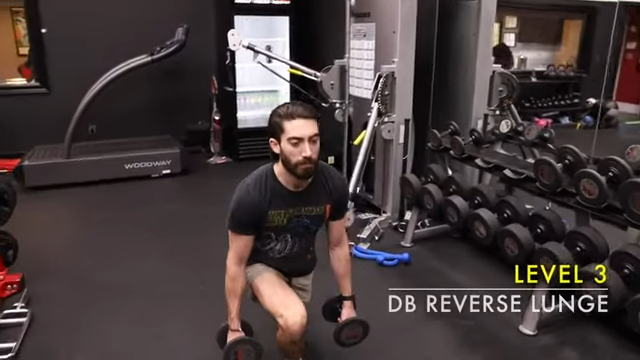
HOW TO DO THE DUMBBELL REVERSE LUNGE:
- Stand upright with your feet about hip-width apart, holding a dumbbell in each hand.
- Let your arms hang straight down, with your palms facing your body. Keep your upper body straight, shoulder blades pulled back, and core engaged.
- Take a step back with your left foot, positioning it slightly off to the side. This adjustment helps improve balance and stability.
- As you step back, bend both knees to lower your body into the lunge position. Your front thigh should be parallel to the ground, and your rear knee should hover just above the floor.
- Ensure your front knee stays aligned with your toes and doesn’t extend past them. Your feet should remain flat on the ground, and your upper body should stay upright. Engage your core muscles to maintain stability and prevent wobbling.
- Push through the heel of your front foot to return to the starting position. This action helps engage the gluteal muscles and ensures proper knee alignment. Keep your movements smooth and controlled to avoid unnecessary strain.
- Perform the same motion with the other leg, alternating legs for the desired number of reps.
WHAT MAKES IT EFFECTIVE: Reverse lunges are highly effective because they reduce the risk of knee injury by allowing the rear knee to absorb impact gradually, while also targeting key muscles like the glutes, hamstrings, and quadriceps for balanced leg development and improved overall stability. This makes them a superior choice for enhancing strength and function in everyday movements.
LUNGE VARIATIONS
Lunges are a versatile exercise, and incorporating different variations can target various muscles, improve balance, and add challenge to your workouts.
Working with a personal trainer or on your own, these lunge variations help avoid common mistakes and engage stabilizer muscles.
From Bulgarian Split Squats to Walking Lunges, each type offers unique benefits.
Including these variations in your routine enhances muscle balance, hip flexibility, and overall lower body strength.
Let’s explore different lunges to keep your workouts engaging and impactful.
BULGARIAN SPLIT SQUAT FOR THE QUADS

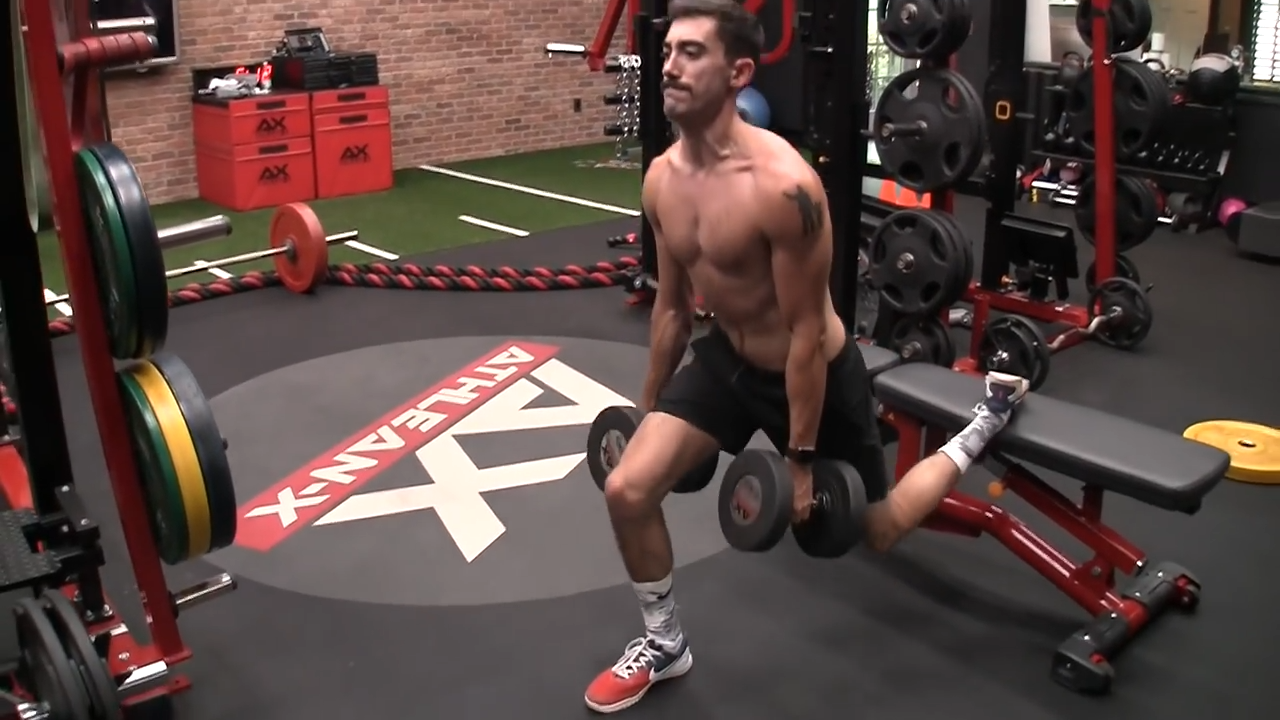
HOW TO DO THE BULGARIAN SPLIT SQUAT FOR THE QUADS:
- Stand with your feet hip-width apart, facing away from a bench. Place your left foot behind you on the bench, ensuring your feet are about shoulder-width apart for stability. This setup is crucial for maintaining balance during the exercise.
- Keep your upper body upright, with your shoulder blades pulled back and your chest lifted. Maintaining this posture is important to target the correct muscles and avoid common mistakes.
- Slowly bend your right knee to lower your body into a squat position. Your right thigh should become parallel to the ground, while your left knee moves toward the floor. Ensure your right foot remains flat and your knee aligns with your toes to avoid knee roll and other issues.
- Push through your right heel to return to the starting position. This movement pattern engages your quads, helping to build larger muscles and enhance bone health. Use challenging weights to increase intensity, but focus on correct form to prevent health issues.
- Repeat the motion for the desired number of reps, then switch legs.
WHAT MAKES IT EFFECTIVE: The Bulgarian Split Squat effectively targets the quads by isolating one leg at a time, enhancing strength, stability, and muscle development while maintaining an upright upper body posture.
BULGARIAN SPLIT SQUAT FOR THE GLUTES

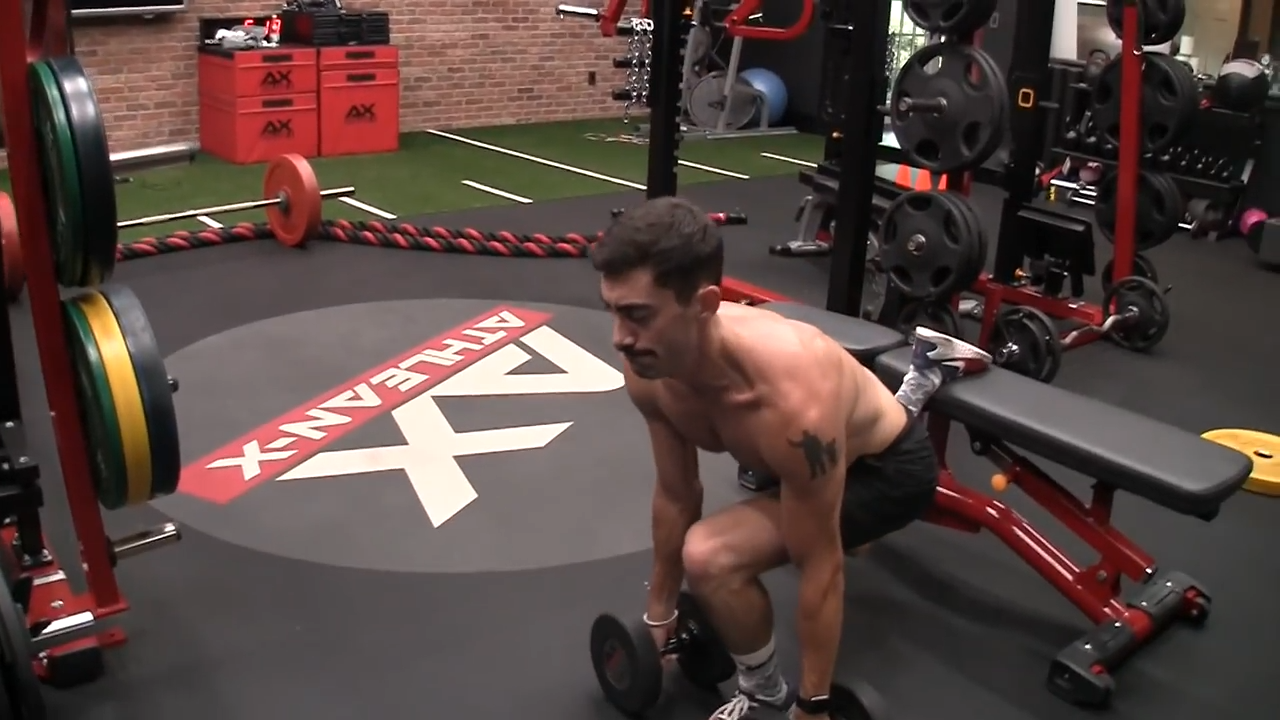
HOW TO DO THE BULGARIAN SPLIT SQUAT FOR THE GLUTES:
- Stand with your feet hip-width apart, facing away from a bench. Place your left foot behind you on the bench. Ensure your feet are about shoulder-width apart to maintain balance.
- Bend forward at the waist to shift the focus from the quads to the glutes. This adjustment is crucial for effectively targeting the glute muscles.
- Slowly bend your right knee to lower your body into a squat position. Your left knee moves downward, and your right thigh parallel to the ground. Keep your front foot flat and ensure your knee bends properly to avoid any health issues.
- As you lower yourself, the slight forward bend helps engage the glutes more intensely. This movement pattern ensures that the biggest muscles in your lower body are being worked efficiently.
- Push through your right heel to return to the starting position. This helps in maximizing glute engagement and ensuring proper form.
- Perform the same motion for the desired number of reps, then switch legs.
WHAT MAKES IT EFFECTIVE: This Bulgarian Split Squat variation effectively targets the glutes by incorporating a slight forward bend at the waist, shifting the focus from the quads to the glute muscles for enhanced engagement and strength development.
WIDE STANCE WALKING LUNGES

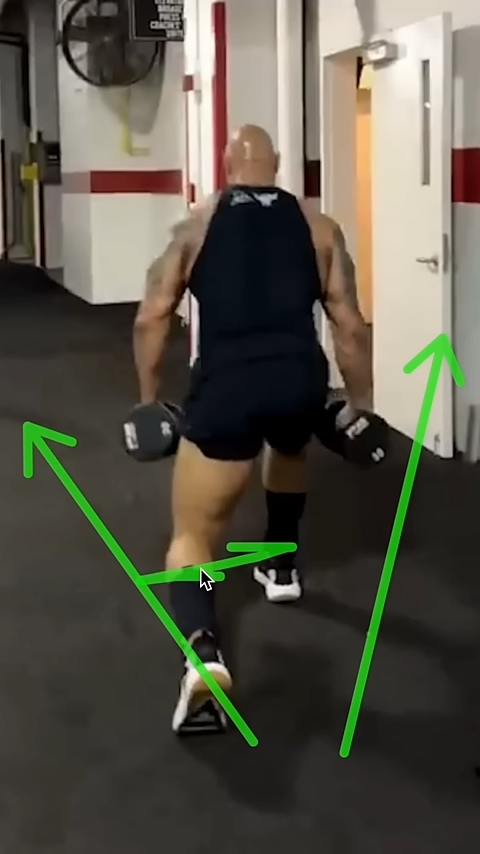
HOW TO DO WIDE STANCE WALKING LUNGES:
- Stand with your feet hip-width apart and your upper body upright. Engage your core muscles for stability.
- Take a giant step forward with your right foot, but slightly off to the side to eliminate the stability challenge. Your feet should be about shoulder-width apart in this position.
- Bend both knees to lower your body into a Lunge. Your right thigh should be parallel to the ground, and your left knee should move downward without touching the floor. Ensure your front knee is aligned with your toes to avoid knee bending to the side.
- Push through your right heel to lift your body up and step forward with your left foot, again slightly off to the side. Continue the motion, alternating legs with each step.
- Keep your upper body upright and your shoulder blades pulled back throughout the exercise. Focus on a fluid motion, maintaining a wide stance to engage the correct muscles effectively.
WHAT MAKES IT EFFECTIVE: The benefits of Walking Lunges include engaging the glutes, hamstrings, and inner thighs while improving stability and balance, making them ideal for people with healthy knees.
OFFSET DUMBBELL LUNGE

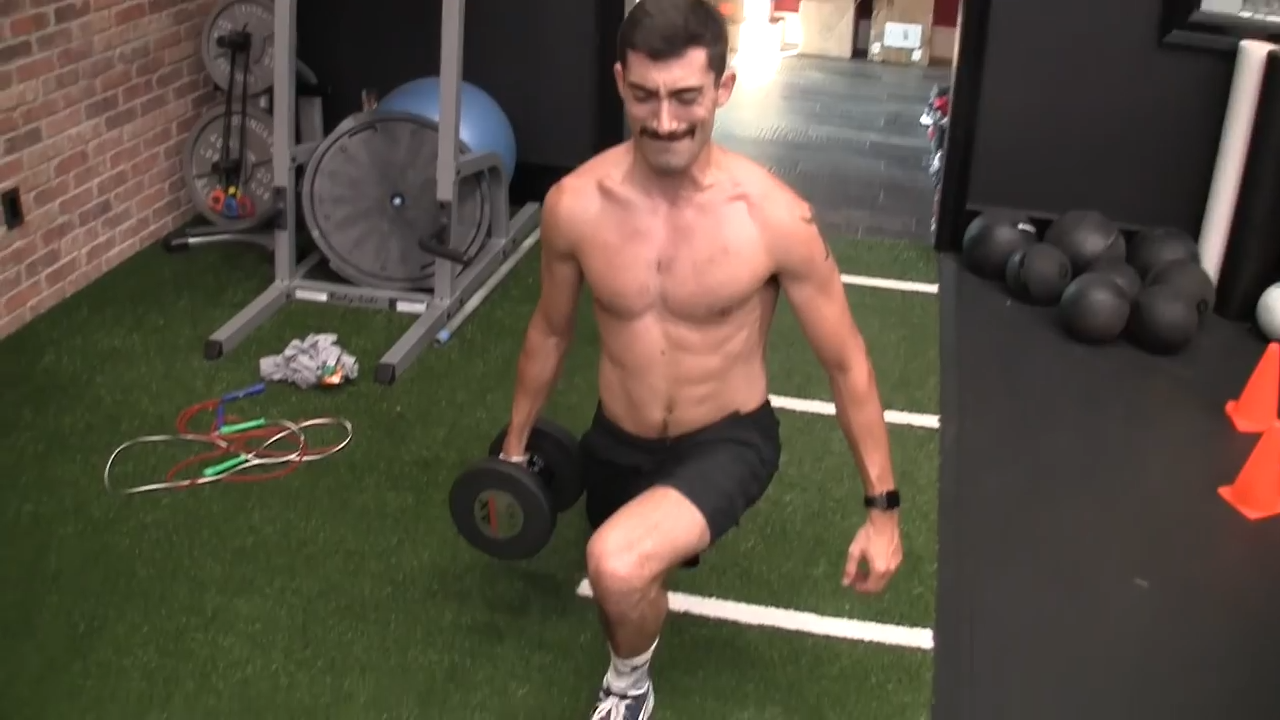
HOW TO DO THE OFFSET DUMBBELL LUNGE:
- Stand upright with your feet hip-width apart, holding a dumbbell in one hand at your side. Your other hand can be placed on your hip or kept straight for balance. Ensure your upper body remains upright and your core engaged.
- Take a step forward with your right foot, maintaining an upright posture. Your feet should be about shoulder-width apart to ensure stability.
- Bend both knees to lower your body into a Lunge position. Your right thigh should be parallel to the ground, and your left knee should move downward without touching the floor. Keep your knee aligned with your toes and your front foot flat on the ground.
- Push through your right heel to return to the starting position. Ensure your motions are controlled and your core remains engaged to maintain balance.
- After completing the desired number of reps, switch the dumbbell to your other hand and perform the lunges with your left leg stepping forward.
WHAT MAKES IT EFFECTIVE: The Offset Dumbbell Lunge enhances lower body strength while improving core stability and balance by holding a weight on one side, challenging the body’s ability to maintain proper form.
GOBLET ADDUCTOR LUNGE

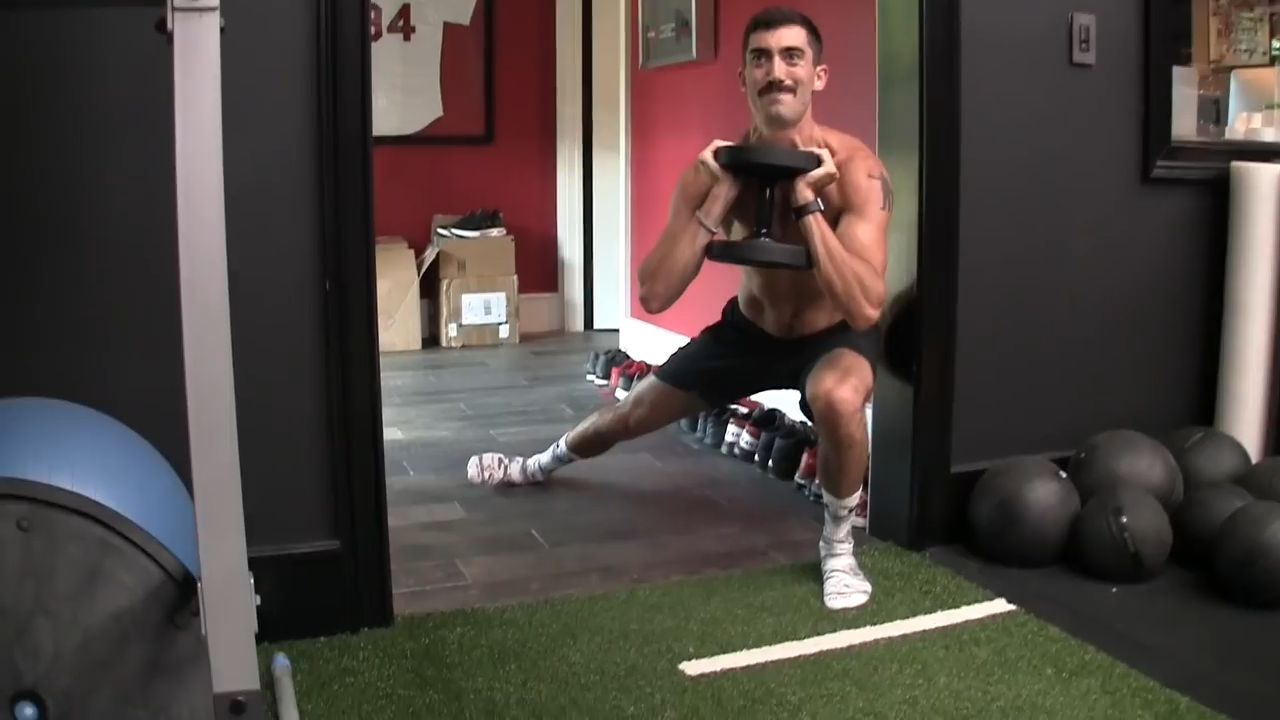
HOW TO DO THE GOBLET ADDUCTOR LUNGE:
- Stand with your feet hip-width apart and hold a dumbbell close to your chest, grasping it with both hands like you would during a goblet squat. Keep your elbows close to your body and your core engaged.
- Slide your right leg out to the side while bending your left leg into a lunge position. Your right foot should land far enough to create a wide stance, allowing you to lower your body effectively.
- Bend your left knee and push your hips back as you lower your body into a lunge. Your right leg should remain straight, and your left thigh should become parallel to the ground. Keep your chest up and your upper body upright.
- Push through your left heel to slide your right leg back to the starting position, maintaining control and stability throughout the movement.
- After completing the desired number of reps on the left side, switch to the right leg and repeat the entire lunge.
WHAT MAKES IT EFFECTIVE: The Goblet Adductor Lunge is effective because it targets the inner thighs and enhances leg stability while engaging the core, providing a comprehensive lower body workout.
Guys, I know you’ve probably heard that regular Lunges are a must for every lower body workout, but I’d argue that there are better options out there.
Reverse Lunges, in particular, can provide the same (if not better) benefits as the forward lunge without the risk of strain and injury.
I’d suggest swapping out your Forward Lunges for Reverse Lunges and see the difference they can make for you.
Don’t have a fully structured lower body muscles workout program? We can help with that! Check out our ATHLEAN-X programs to see which is the best fit for your goals and fitness level.

- Forward lunges can be harsh on the knee due to the front leg’s open chain position, which absorbs significant force upon ground contact, and the quadriceps being stretched when the knee is partially flexed, causing stress on the patella tendon.
- Reverse lunges offer a safer alternative by keeping the back leg in a closed chain position, providing better stability, and reducing knee stress, while engaging core and leg muscles more effectively.
- Follow these steps to correctly perform Reverse Lunges:
- Stand tall with your feet hip-width apart, holding a dumbbell in each hand. Keep your arms hanging straight down, palms facing your body.
- Maintain an upright upper body, pulling your shoulder blades back and engaging your core.
- Step back with your left foot, positioning it slightly off to the side for better balance and stability.
- As you step back, bend both knees to lower your body. Your front thigh should be parallel to the ground, and your rear knee should hover just above the floor.
- Ensure your front knee stays aligned with your toes and doesn’t extend past them. Keep your feet flat on the ground, upper body upright, and core engaged to maintain stability.
- Push through the heel of your front foot to return to the starting position. This action engages your glutes and ensures proper knee alignment. Keep your movements smooth and controlled to avoid strain.
- Repeat the motion with the other leg, alternating legs for the desired number of reps.
- Try incorporating Reverse Lunges into your lower body routine to support your goals of muscle mass, strength, and endurance.
HOW TO DO LUNGES FAQS
Lunges are one of the best exercises you can do for lower body strength and stability.
They target key muscles like the glutes, quads, and hamstrings while also improving hip flexibility and core stability.
This unilateral exercise helps correct muscle imbalances and enhances your balance and coordination, making them a crucial movement for both athletes and everyday gym goers.
Plus, with variations like Reverse Lunges, Walking Lunges, and Side Lunges, you can continually challenge your body and prevent workout monotony.
Incorporate this functional exercise into your routine to build strength, boost athletic performance, and support overall joint health.
Both Lunges and Squats offer unique advantages and are essential for a balanced workout.
Lunges are excellent for addressing muscle imbalances and enhancing stability and coordination because they work each leg independently.
They also engage your core more effectively, boosting functional strength.
Squats, however, are unmatched for building overall mass and strength in the glutes, quads, and hamstrings, promoting significant lower body power.
The optimal strategy is to include both exercises in your routine:
Use Squats to build foundational strength and Lunges to improve balance, stability, and unilateral strength.
Together, they provide a comprehensive lower body workout that maximizes your results.
Absolutely, lunges can increase thigh size.
By targeting the quadriceps, hamstrings, and glutes, Lunges promote muscle growth and hypertrophy in the thighs.
Consistently incorporating Lunges into your workout routine, especially with added heavy weights like dumbbells or a barbell, can significantly enhance the size and strength of your thigh muscles.
To maximize growth, ensure you're performing lunges with proper form and progressively increasing the resistance.
To perform Lunges correctly, start by standing with your feet hip-width apart and your upper body upright, engaging your core muscles for stability.
Take a step forward with your right foot, slightly off to the side to eliminate the stability challenge, positioning your feet about shoulder-width apart.
Bend both knees to lower your body into a lunge, ensuring your right thigh is parallel to the ground and your left knee moves downward without touching the floor.
Make sure your front knee is aligned with your toes to avoid knee bending.
Push through your right heel to lift your body up and step forward with your left foot, again slightly off to the side, and continue the motion, alternating legs with each step.
Throughout the exercise, keep your upper body upright and your shoulder blades pulled back, focusing on a fluid motion, and maintaining a wide stance to engage the correct muscles effectively.
This technique maximizes the benefits of Lunges while minimizing the risk of injury.
REFERENCES
Muscle activation and length changes during two lunge exercises: Implications for rehabilitation . Scandinavian Journal of Medicine & Science in Sports.

Jeff Cavaliere M.S.P.T, CSCS
Jeff Cavaliere is a Physical Therapist, Strength Coach and creator of the ATHLEAN-X Training Programs and ATHLEAN-Rx Supplements. He has a Masters in Physical Therapy (MSPT) and has worked as Head Physical Therapist for the New York Mets, as well as training many elite professional athletes in Major League Baseball, NFL, MMA and professional wrestling. His programs produce “next level” achievements in muscle size, strength and performance for professional athletes and anyone looking to build a muscular athletic physique.
















